|
|
|
Sort Order |
|
|
|
Items / Page
|
|
|
|
|
|
|
| Srl | Item |
| 1 |
ID:
148496


|
|
|
|
|
| Summary/Abstract |
The paper looks at the concept of political ‘hybridity’ within the broader framework of Pakistan’s domestic politics. Whilst analysing Pakistan’s domestic politics, most analysts tend to view the country’s political system as authoritarian and label it as a military dictatorship. Whilst this has been true for most of Pakistan’s history since it came into existence in 1947, it is also equally important to look at the role played by the more democratic elements of Pakistani society in politics, and the interactions that have taken place between the more democratic forces on the one hand, and the more authoritarian elements on the other. This paper moves away from traditional ways of viewing Pakistan’s domestic politics and focuses more on the grey areas, instead of viewing the country in black or white terms. In doing so, the paper has a strong focus on Ayub Khan’s concept of Basic Democracy.
|
|
|
|
|
|
|
|
|
|
|
|
|
|
|
|
| 2 |
ID:
103922
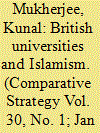

|
|
|
|
|
| Publication |
2011.
|
| Summary/Abstract |
This article tries to look into the question, to what extent have British universities become the new recruiting grounds of Islamism, if at all, making a shift from Mosques. It argues that both Islam (the religion itself) and Islamism (the political ideology) coexist at the university level. At universities both moderate thinkers and Islamists are invited to give their speeches, a small few of whom openly advocate terrorism or what Islamists would call "martyrdom." The article moves away from the traditional reactive explanations and tries to give both an active and reactive explanation as to what causes Islamism in Britain among British Muslim university students and analyzes the causes within the broader framework of identity issues and socioeconomic marginalization. It has been advised that social policy workers in Britain dealing with ethnic minorities collaborate with security officials while dealing with the problem of Islamism.
|
|
|
|
|
|
|
|
|
|
|
|
|
|
|
|
| 3 |
ID:
101133
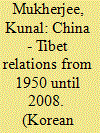

|
|
|
| 4 |
ID:
139541
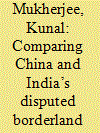

|
|
|
|
|
| Summary/Abstract |
The paper tries to make an assessment of the borderland regions of China and India with a focus on Xinjiang, Tibet, Kashmir and the Indian Northeast. The paper looks at the conflict in India and China's periphery, how these conflicts have evolved with time and how they have changed their character with the passage of time, from the 1950s until the present day. After looking at some background, the paper primarily focusses on three key issues which impact on all four of the conflicts: the rise of ethnic nationalism, the impact of external forces on the conflict and the human rights situation. After making an assessment of the political situation, the paper looks at the areas of similarity and differences between the four regions. Methodologically, a bottom-up approach was taken and in-depth unstructured interviews were carried out with people from the conflict zones that the paper considers.
|
|
|
|
|
|
|
|
|
|
|
|
|
|
|
|
| 5 |
ID:
179347
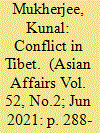

|
|
|
|
|
| Summary/Abstract |
This article looks at the internal and external dimensions of the on-going Tibetan conflict and argues that these two facets of the conflict are intertwined and should not be viewed separately or independent of one another. Internally, the factors which have contributed to the conflict include repressive Chinese state policies such as Han migration from China proper to Tibet, economic development in Tibet as defined by the Chinese state, and the Patriotic Education Campaigns (PEC) to mention just a few. Externally, foreign powers like India and the US have been involved. India, for instance, has provided Tibetan monks and the Dalai Lama with refuge after the Chinese invasion of Tibet in the 1950s. Extensive field trips were undertaken to both India and China from 2015-2019 to carry out the research for this article. In addition to using a range of secondary source material, this article makes use of participant observation as a key research method to further its arguments.
|
|
|
|
|
|
|
|
|
|
|
|
|
|
|
|
| 6 |
ID:
135937
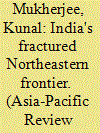

|
|
|
|
|
| Summary/Abstract |
The paper tries to analyze the different layers of the conflict in the remote Indian northeast. It looks at the different facets of this conflict, and argues that the conflict in the Indian northeast exists at many different levels. In relation to the different facets of the conflict, the paper has a special focus on human rights abuses, poverty, corruption, poor governance, administrative failure, the role played by external actors, and draconian laws such as the Armed Forces Special Powers Act. Most of the conflicts have been associated with strong separatist tendencies and the issue of migration. The levels of violence have differed from place to place within the region. While violence has been successfully dealt with by the Indian government in states like Mizoram, the situation in states like Assam, Manipur, and Nagaland seems to be a work in progress. Assam, Manipur, and Nagaland have witnessed very high levels of violence since 1947, when India became independent from British colonial rule, until the present day. Methodologically, the paper follows a bottom up approach, and, to get first-hand information about the conflict, a series of interviews was conducted recently with some of the local residents of the region. The paper suggests demilitarization and infrastructure development in the region as the way forward.
|
|
|
|
|
|
|
|
|
|
|
|
|
|
|
|
| 7 |
ID:
101501
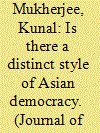

|
|
|
|
|
| Publication |
2010.
|
| Summary/Abstract |
For a long time, especially through orientalist writings, Eastern or Asian political systems were seen as inherently authoritarian and as the antithesis of the West or Western political systems. Although there is some truth to this, there are aspects of Asian politics and culture which are very much in keeping with Western understandings of political liberalism and this paper tries to focus on some of these similarities. The paper tries to look into the question, 'Is there is a distinct style of Asian democracy'? The paper argues that there are aspects of Asian culture and politics which sit comfortably with Western notions of liberalism and other aspects which do not. However, for the aspects which do not, these have a lot to do with politicians using aspects of the Asian political tradition, like acceptance of hierarchy and respect for authority, to consolidate their own position when their power base lacks political legitimacy. Before making an assessment of the political systems in Asia, one also has to look at specificities and the particular historical, geographical and sociological context each country is grounded in. This paper has a special focus on South and East Asia and thus makes use of a comparative approach, whilst trying to answer its research question.
|
|
|
|
|
|
|
|
|
|
|
|
|
|
|
|
| 8 |
ID:
128040
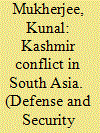

|
|
|
|
|
| Publication |
2014.
|
| Summary/Abstract |
This article looks at the Kashmir conflict in South Asia, which has been going on since 1947, when India and Pakistan became independent from British colonial rule. After looking at some historical background, the article looks at both the external dimension as well as the internal dimension of the conflict. The external dimension tends to focus on Indo-Pak relations over Kashmir and the internal dimension looks at India's repressive state policies within the state of Kashmir. This article uses Mary Kaldor's "New War" thesis as a theoretical framework to understand the situation and pays special attention to the conflict's very complex and multifaceted nature. The article argues that although the levels of violence have differed from time to time in the region since 1947, today the conflict seems to have less to do with Indo-Pak relations or the external side of things and has more to do with the internal dimension and India's undemocratic ways within Kashmir. Today, Kashmir is one of the most militarised conflict zones in the world. The stationing of the Indian military and paramilitary forces in the region has only exacerbated the situation since it is the security personnel who cause much of the problem. The Armed Forces Special Powers Act gives these security forces extraordinary powers in the region, which they often abuse. The armed forces have no real understanding of the local culture or sympathy for local religious sentiments. Poverty, corruption, administrative failure, police brutality, identity politics and human rights abuses are some of the key features associated with this conflict. Methodologically, a number of interviews were carried out with the local people in the region recently. From the data gathered through the interviews, it is very obvious that the people still feel very oppressed and that the situation is still very volatile, fraught with uncertainty. Finally, after making an assessment of the situation, the article tries to suggest methods of peaceful building and conflict management as the way forward.
|
|
|
|
|
|
|
|
|
|
|
|
|
|
|
|
| 9 |
ID:
126119
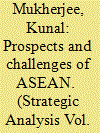

|
|
|
|
|
| Publication |
2013.
|
| Summary/Abstract |
Regionalism has been an important force in international relations since 1945. The aim of this article is to make an assessment of one of the major regional organisations from the Asia Pacific, the ASEAN, or Association of South East Asian Nations. The article attempts to give readers an overview of the problems and prospects of the ASEAN. Although the ASEAN has been successful to a large extent as a regional body, regionalism in South East Asia has been considerably undermined by a number of factors since its creation in 1967. However, in the final analysis, it has been argued that with increasing democratising tendencies in the region and with increasing economic liberalisation, the ASEAN seems to have a bright future.
|
|
|
|
|
|
|
|
|
|
|
|
|
|
|
|
| 10 |
ID:
095959
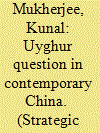

|
|
|
|
|
| Publication |
2010.
|
| Summary/Abstract |
This article examines the policies the Chinese state has taken towards the Uyghur Muslim community in Xinjiang since the Cultural Revolution and tries to analyse to what extent have these changed with time. The article argues that the Uyghur community has been seen as a threat to the stability of the state, which is why harsh measures have been directed towards this ethnic group. The party has tried to maintain control over these groups by force by attempting to confine all forms of religious activity and by suppressing any independent body. This is because religion generally and Islam in particular (which is practised by most Uyghurs) are not viewed favourably by Chinese officials, since religious ideology did not sit comfortably with what the state considered to be nationalist patriotic values. However, recent democratising tendencies, which have implications for all religious groups, also need to be taken into consideration before making an assessment of the situation. Recent events have shown us that Chinese state policies do not necessarily move in a straight line.
|
|
|
|
|
|
|
|
|
|
|
|
|
|
|
|
| 11 |
ID:
094115
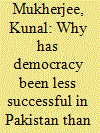

|
|
|
|
|
|
|
|